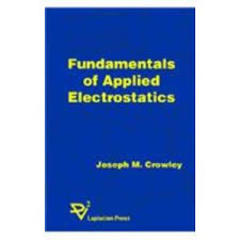
Fundamentals of Applied Electrostatics
Joseph M. Crowley
(1999) 272 pages
Explains, in engineering rather than mathematical terms, the application of electrostatic principles for designing practical devices. Each part concentrates on a single electrostatic concept with application to a particular device.
This book, now in its third printing, is organized by the scale of electrostatic effect. Part One deals with electrostatic fields in a uniform linear medium. Part Two introduces particles in the field. Part Three allows for a complex continuum. Part Four describes interactions between electrostatic devices and external circuits using terminal relations.
Contents
Fundamental concepts
Voltage and electric field; charge and electric displacement; material properties (capacitance and permittivity); charge conservation and current; resistance and conductivity
Electric fields with known voltages
Two flat layers (high voltage bushing design); coaxial cylinders (voltage rating of coaxial cables); spherical geometry (maximum charge on ink drop printer); cylinders and spheres in external fields (St. Elmo's fire; bubble breakdown in insulating oils)
Fields caused by charges
Surface (xerographic development); space charge (grain elevator explosions); moving charge (radiation detectors)
Particle motion in known electric fields
Time-dependent fields (reflex klystrons); space-dependent fields (electron beam waist); drag forces (ink jet printers); mobility (corona charging of particles).
Unipolar space-charge motion
mobility and space charge (charges in a tank); mobility, space charge, and external fields (xerographic corotrons); inertial motion in space-charge fields (ion rockets)
Charged particle conservation
Basic laws (ionization gauge); charge decay (decay of ionospheric disturbance); charge convection and characteristics (static neutralizers); diffusion (semiconductor junction potential)
Conduction and breakdown
When is conduction ohmic? (gas insulation); single species (radiation counters); multiple species (ion bombardment).
Polarization
Artificial linear dielectrics; nonlinear (dielectric saturation); permanent polarization (electret microphones); piezo-and pyroelectricity (infrared television); time-varying fields (microwave ovens)
Continuum force densities
Force densities (ion drag pumps); polarization forces (spacecraft fuel management); Maxwell stress tensor (electric field meter)
Resistive circuit elements
Nonlinear resistors (varistor surge arrestors); resistors with variable geometry (field effect transistors); resistors with variable material properties (thermistor runaway).
Capacitive circuit elements
Nonlinear capacitors (varactor frequency multipliers); electromechanical current generators (rotating generation); capacitors with variable dielectrics (ferroelectric pulse generators); multiple terminals and mutual capacitance (droplet charging in ink jet printers)
Forces on lumped elements
Linear forces (electrostatic loudspeakers); torque calculation (electrostatic display signs); forces from coenergy (ferroelectric forces); forces in multiple terminal devices (electrostatic motors)
Contact us at info@electrostatic.com
 Electrostatic Applications
Electrostatic Applications